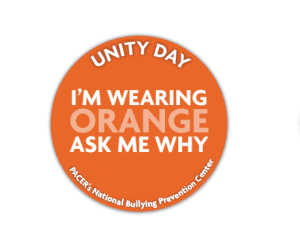The Internet has revolutionized much of modern life, especially when it comes to education. There are benefits when students can learn and socialize in online spaces, but it comes with a dark side.
Nearly three out of five U.S. teens say they have been harassed or bullied online. And most youth say adults aren’t doing enough to stop it.[1] Hate speech has flourished online, with racist, sexist, homophobic, and other speech sometimes leading to real-world violence or harm.
When bullying or hate speech happens in person, on school grounds, taking disciplinary actions for the aggressors and knowing how to aid the victims can be obvious. when that harassment is online, taking the right actions feels murkier. October is Bullying Prevention Month, so here are some things to know about online bullying and hate speech.
 What Is Online Bullying, and How Widespread Is It?
What Is Online Bullying, and How Widespread Is It?
Online bullying, or cyberbullying, has many of the same characteristics as other types of bullying in schools, but it takes place over cell phones or the Internet. It can be channeled through social media posts, while gaming, through direct messages, and much more.[2]
Cyberbullying statistics show that 59% of teens have reported being the target of cyber bullying, with name-calling, spreading rumors, and receiving explicit images they didn’t ask for as some of the most prevalent abusive behaviors.[1]
Cyberbullying has unique characteristics that make it especially troubling. While real-world bullying at least has physical boundaries, cyberbullies can stalk students wherever they go, whether at home or at school. Because many students have 24/7 access to a smartphone, online bullies can follow them around, giving no sense of relief. The victim can’t just walk away. It also is more permanent and pervasive—posts or messages can spread like wildfire and remain online indefinitely. Cyberbullying is also easier to hide from teachers or parents, who aren’t privy to the online communications students share.[2]
While cyberbullying can happen outside the school grounds, it can also take place and affect children when they’re in school. Of students who said they were bullied at school during the school year, 15% were bullied online or by text.[3]
Some common types of cyberbullying go beyond name-calling, though that is the most common kind, with 42% of teens saying they’ve been called names online. About a third of teens said someone has spread false rumors about them online, 21% report online stalking, and 16% say they’ve been the target of physical threats.[1]
When Online Speech Becomes Hate Speech
Most people who’ve been online have seen content that pushes the line of acceptable behavior or good taste but is protected in the United States by the First Amendment. Things get trickier when the content could be considered hate speech, and school professionals may need to take action.
What is hate speech? There’s not a concrete definition, but it can be any form of expression (online or off) intended to “vilify, humiliate, or incite hatred against a group or class of people.” Hate speech is like bullying in that it’s marked by aggressive behavior toward another. It’s different in that it specifically targets someone or a group of people for their characteristics.[10]
Bullying that centers on things like race, national origin, immigration status, sexuality or gender identity, and more could all be classified as hate speech. In the online world, that “speech” can extend beyond words and include memes or videos. Sometimes it’s difficult to nail down whether something is hate speech, especially when the poster will use dog whistles (a derogatory term with enough plausible deniability) or innocuous language in their messages.[4]
Hate speech online has been linked to real-world acts of harm and violence. Researchers found that perpetrators of racist attacks like those in Charleston, South Carolina, or El Paso, Texas, and more have often been active in online spaces where hate speech and conspiracy theories flourish.[9] Social media, with sophisticated algorithms fine-tuned to capture the user’s attention, allows ideas to spread quickly.
Freedom of Speech in Schools, Hate Speech, and Bullying
Free speech is guaranteed by the First Amendment to the Constitution. Just because something is offensive does not mean that it’s illegal or requires school discipline. But there are instances where online speech crosses the line.
In a 1969 case (Tinker v. Des Moines Independent School District), courts ruled that students do have the right of freedom of speech in schools unless that speech “materially and substantially interfere with the requirements of the appropriate discipline in the operation of the school.”[4]
When it comes to online issues, a 2017 court ruling determined that social media activity that happens off campus can still be considered school speech, if those acts or posts were made by students and with the intention to disrupt school.
School districts and state policies might dictate an educator’s next steps when they suspect cyberbullying.[8] Half of US states have laws about bullying in schools, and 12 states have laws specifically targeted at cyberbullying in elementary schools.[13]
Districts have been sued for inaction when it comes to cyberbullying. That’s why some districts have started monitoring their students’ social media accounts. The methods range from simple alerts for mentions of the schools or “friending” students, to hiring outside firms to monitor social media and taking disciplinary action on problematic posts.[11] However, that’s led to questions about students’ rights. Civil rights advocates encourage schools to be mindful and handle online problems appropriately, while also respecting students’ free speech and privacy rights.[6]
How to Recognize and Help a Student Being Cyberbullied
Students can be traumatized by bullying or hate speech, even if there’s no physical violence involved. That’s just as true for cyberbullying and online hate speech. Even if the harassment is virtual, the pain is real. That’s when it can become an issue of discipline and require counseling in the school.
Because online bullying is almost impossible to overhear or see in the classroom, educators can be unaware it’s happening. The clues can be subtle, but may include signs from students who:
● Suddenly and unexpectedly stop using devices
● Become uneasy about going to school
● Attempt to avoid unstructured time
● Request not to work in groups or with a specific student
● Avoid discussions about what they are doing online[7]
In addition, students may exhibit classic symptoms of being bullied, like:
● Depression and anxiety
● Low self-esteem
● Showing signs in class of not getting enough sleep
● Chronic stress
● Self-destructive behaviors[12]
Many signs may not be immediately obvious or could indicate other problems. But adults must be ready to help a student who may be victimized by online hate speech or cyberbullying.
Educators can work with families to identify cyberbullying and promote positive, safe, and responsible media use. Educators can also help create a safe environment by publicly stating that harassment and intimidation have no place in schools, refusing to downplay hate speech, and showcasing other positive behaviors.
One thing that’s crucial to a students’ well-being is knowing that adults are there for them.
Child Psychologist Dr. Howard Stevenson says that children who have been victims of racial trauma tell him that the most hurtful moment isn’t the actual threat, “but when they realized the adults who were supposed to protect them had stayed silent.” Stevenson said educators must prepare themselves to speak out for their students.[5]
Sources:
1. Anderson, Monica. “A Majority of Teens Have Experienced Some Form of Cyberbullying.” Pew Research Center. https://www.pewresearch.org/internet/2018/09/27/a-majority-of-teens-have-experienced-some-form-of-cyberbullying/
2. Stopbullying.gov. “What is Cyberbullying.” https://www.stopbullying.gov/cyberbullying/what-is-it
3. National Center for Education Statistics. “Indicator 10: Bullying at School and Electronic Bullying.” https://nces.ed.gov/programs/crimeindicators/ind_10.asp
4. Heller, Brittan and Larry Magid. “Parent’s and Educator’s Guide to Combating Online Hate Speech.” https://www.connectsafely.org/hatespeech/
5. The Educator’s Playbook. “How to Confront Hate Speech at School.” https://www.gse.upenn.edu/news/educators-playbook/how-confront-hate-speech-school
6. American Civil Liberties Union. “Preventing Harassment and Protecting Free Speech in School.” https://www.aclu.org/other/preventing-harassment-and-protecting-free-speech-school
7. Cyberbullying Research Center. “Cyberbullying Warning Signs.” https://cyberbullying.org/cyberbullying-warning-signs
8. Oh, Erin Wilkey. “Teachers’ Essential Guide to Cyberbullying Prevention.” Common Sense Education. https://www.commonsense.org/education/articles/teachers-essential-guide-to-cyberbullying-prevention
9. Laub, Zachary. “Hate Speech on Social Media: Global Comparisons.” Council on Foreign Relations. https://www.cfr.org/backgrounder/hate-speech-social-media-global-comparisons
10. United Nations. “United Nations Strategy and Plan of Action on Hate Speech.” https://www.un.org/en/genocideprevention/documents/UN%20Strategy%20and%20Plan%20of%20Action%20on%20Hate%20Speech%2018%20June%20SYNOPSIS.pdf
11. PBS News Hour. “Schools are watching students’ social media, raising questions about free speech.” https://youtu.be/pQ1Zr-zEwpc
12. Waterford.org. “Your Guide to Preventing and Responding to School Bullies.” https://www.waterford.org/education/how-to-respond-to-bullying-in-schools/
13. Redmond, Jodee. “Cyberbullying in Elementary School.” Love to Know. https://kids.lovetoknow.com/wiki/Cyberbullying_Elementary_School





